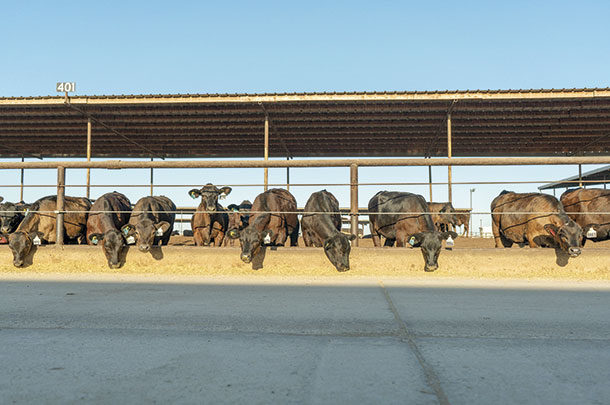However, for some cattle buyers, the readily available dairy crossbred cattle volume is not outweighing the problems they are bringing with them to the beef industry.
Every stop along the supply chain journey, from calf ranch and feedlot to packer and consumer marketing, has expressed concern toward the negative trends coming from dairy crossbred cattle. These supply chain stops are the trickle-down price setters for beef-on-dairy calves. It has caused, in some regions, deep price discounts on the purchase price from dairies.
Calf welfare
Consumers have an idealistic view of beef cattle roaming the range. Confinement housing, such as hutches used for pre-weaning beef-on-dairy calves, brings a consumer perception concern for beef marketing groups.
This has recently become a topic for the beef industry due to beef-on-dairy calves. Are these crossbred cattle adding another stressor for cattle marketing? If yes, is the product worth the additional pain point?
In some situations, it is not.
Dairy producers have become notorious for passing the buck of calf care to the calf buyer or calf ranch. Beef-on-dairy calves not given high-quality care as newborns before leaving the dairy have a high possibility for stunted lifetime performance. Management mistakes early in life can slow growth rates causing more days on feed, reduce calf thriftiness, damage gut health and require expensive inputs such as labor and medication.
Work with your veterinarian and calf buyer to develop a standardized operating procedure for beef-on-dairy calf care that optimizes calf health, reduces potential antibiotic needs and enhances the value of calves with assumed minimized health issues.
Carcass discounts
Historically, a big topic for packers working with dairy crossbred cattle was steers being too tall to hang on the rail correctly. However, when using correct complementary beef genetics for dairy cattle, size at harvest is no longer a large concern. Stature is highly heritable and has proven to be correctable for dairy crossbred cattle. Today’s biggest concerns for dairy crossbred cattle are gut health issues relating to liver abscesses and heart or lung damage.
When an irregularity is found on a carcass, it is expensive. As soon as that chain shuts off, it is costing the industry. Pausing the harvest line to clean abscesses or viscera tables results in slowed production and an inactive employee crew standing around waiting for harvest to resume. Downtime in a major plant can cost thousands of dollars per minute.
The next financial hit is from offal loss, which can be a significant dollar amount per head depending on the location and severity of the abscess. If abscesses are found and stamped, instead of being exportable, the offal goes to rendering for pennies on the dollar.
Packers will use the entire carcass if they can – but to be able to use every possible carcass byproduct at the highest value, it is critical to have the carcass free of abnormalities and qualified for export through verification programs.
The greatest global market accessibility comes with cattle verification programs. The USDA Process Verified Program (PVP) sets specific genetic standards and the USDA Quality System Assessment (QSA) for source and age verification. For example, this is required for export to most Asian country markets. The Non-Hormone Treated Cattle (NHTC) program opens even more market options, such as the European Union.
Minimize potential for abscesses
Research is being done to see what management steps can be taken for reduced abscess frequency. Some theories are linking this problem with calfhood nutrition and early- in-life gut health stressors, such as antibiotics or hospital milk with high pathogen loads, unsanitary environments and poor-quality milk replacer. Cheap calf care practices can become very expensive when looking at lifetime profitability.
Chuck Stokke, chief operating officer of Calftech Corporation, urges anyone caring for calves to spend more on nutrition and it will balance out with less spending on antibiotics. Calftech Corp. in California’s Central Valley is one of the West Coast’s largest custom calf-raising operations. They were also the leader, by a wide margin, in calf ranch graduates with the lowest number of liver abscesses in a recent comparison trial among a few calf ranches. This trial encourages the idea that liver abscesses at harvest could be connected to calf care.
Stokke has very straightforward, common-sense philosophies when it comes to calf rearing: minimize stress, develop – don’t disrupt – gut health, and “don’t vaccinate out of a problem.”
In addition to calf care, other abscess cause theories include toxic levels of copper in the bloodstream. Mineral shed from the dam can cause a high concentration of copper in calves at birth. Stressors cause the copper toxin to be released into the bloodstream. This can compound the pathological issues.
Plant efficiency
Incorrect beef genetics crossed with dairy cattle reduces overall carcass yield. Some dairy producers are limiting yield efficiency and creating an undesirable product with their beef sire choices. High genetic index beef-on-beef EPDs do not always equal quality beef-on-dairy cattle.
The highest priority improvement area for dairy cattle is to add muscle and change the back third of the carcass. Use corrective beef-on-dairy genetics to get rid of what has become disdainfully known as a “buffalo-shaped rear end” in some crossbreds. Increased mass through the round, or rump, region increases overall dress yield and carcass value. Only using ribeye EPDs as a measuring stick for muscling can cause you to miss out on huge yield opportunities.
The beef-on-dairy safety net
Will we reach a crossroads where some packers decide they don’t want to deal with these dairy crossbred cattle?
We have a saving grace for dairy crossbred cattle marketing: an overall decline in the number of beef cattle available. The downward swing in national cattle numbers means that, for now, processors will continue to source dairy crossbred cattle. They will tolerate the liver and reduced yield issues. But it will be at a price.
The packer industry loves to discount prices for products that do not fit their ideal. Inefficiencies are reflected in their buying power. A few major packers have implemented a standardized fee deduction across certain dairy crossbred cattle groups that have unknown health care history or generic beef genetics.
Premium beef-on-dairy calf prices may be harder to achieve unless you can stand behind a documented, value-added product. Know your end consumer. Implement traceability and calf care program welfare standards to best align with strategic marketing throughout the entire supply chain.







